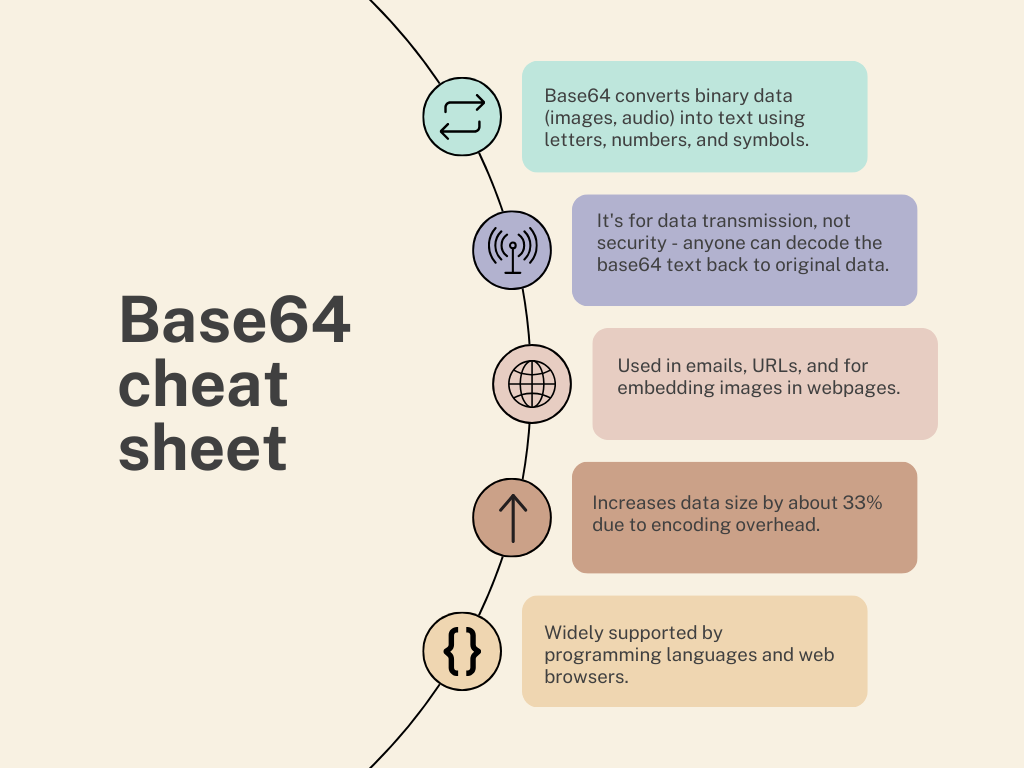Base64 is a widely-used binary-to-text encoding system that plays a crucial role in seamlessly transferring and storing data in various applications.
In this article, we’ll explore how Base64 is used in SQL, MySQL, and SQL Server, three popular database management systems. By understanding how these systems work with Base64, you can enhance your data management skills and ensure efficient storage and retrieval of binary data in your databases.
We’ll delve into the specific functions and techniques used by each of these systems to encode and decode Base64 data, helping you better understand how to work with binary data in your databases. So, let’s dive in and get this party started!
What is Base64?
Base64 is a binary-to-text encoding technique that is commonly used to encode binary data when it has to be preserved and moved across text-based medium. This encoding ensures that the data remains unmodified throughout transport. Base64 is extensively utilized in a broad range of applications, including email and the storage of complex data in XML or JSON.

The binary data is translated into a sequence of 8-bit bytes, which are then represented as 64 distinct printable characters in Base64 encoding, thus the name ‘Base64’. The characters used for the 64 necessary for the base might vary between implementations. The fundamental strategy is to choose 64 characters from a subset that is shared by most encodings and is also printable. Because of this combination, it is unlikely that the data would be changed in transit via services such as email, which were previously not 8-bit clean. For the first 62 values, the Base64 index table comprises A-Z, a-z, 0-9, +, and /. The ‘+’ and ‘/’ characters are used to pad the encoded value at the conclusion.
What is SQL?
SQL (Structured Query Language) is a standard language used to interface with and manage databases. It is especially beneficial when dealing with structured data, which includes relationships between entities and variables.
SQL commands can be used to do a variety of functions, such as querying data, adding new rows, updating or deleting existing data, building and modifying the structure of database systems, and restricting data access. Users can also describe the data using the language. Although SQL has a standard that is periodically updated as the language evolves, many database management systems (DBMS) employ their implementation or dialect of SQL.
There are two main types of SQL: DDL (Data Definition Language) and DML (Data Manipulation Language). DDL includes commands such as CREATE, ALTER, and DROP which handles database schema and the description of how the data should reside in the database. DML includes commands such as SELECT, INSERT, UPDATE, and DELETE which handles data manipulation, and allows users to perform tasks including inserting or deleting rows, retrieving data from the database, and modifying existing data.
Base64 in SQL
In SQL, you can store the Base64 encoded data as a string in a VARCHAR column. This allows you to easily retrieve and decode the data when needed. However, keep in mind that Base64 encoding increases the size of the data by approximately 33%, so this method may not be suitable for very large binary objects.
In SQL, you would normally use built-in functions provided by your SQL dialect to encode or decode Base64 strings. Encoding involves converting binary data (such as a byte array) into a Base64 string. This string is then saved in your database. Decoding involves retrieving the Base64 string from your database and converting it back to binary data.
What is MySQL?
MySQL is a relational database management system (RDBMS) built on SQL. It is one of the world’s most popular open-source databases, noted for its dependability, flexibility, and robustness.
MySQL was created by MySQL AB, a Swedish business formed by David Axmark, Allan Larsson, and Michael “Monty” Widenius. The source code for the project was made available under the GNU General Public License as well as many proprietary agreements. MySQL was owned and supported by a single for-profit corporation, MySQL AB, which is currently owned by Oracle Corporation.
Many database-driven online programs, including Drupal, Joomla, phpBB, and WordPress, use MySQL. The most common use of MySQL is for a web database. It may hold anything from a single piece of information to a whole inventory of items for an online business. As such, it is an essential part of modern web application development.
Base64 Encoding & Decoding in MySQL
MySQL offers built-in functions for performing Base64 encoding and decoding, making it easier to work with binary data in your databases. The TO_BASE64() and FROM_BASE64() functions in MySQL enable developers to easily convert binary data to Base64 format and vice versa, ensuring seamless storage and retrieval of data.
Encoding: MySQL provides a function called TO_BASE64(). This function converts a specified string into a Base64 encoded string.
SELECT TO_BASE64('B64Encode.com');
Decoding with FROM_BASE64(): Similarly, MySQL provides a function called FROM_BASE64(). This function decodes a Base64 encoded string back into its original format.
SELECT FROM_BASE64('QjY0RW5jb2RlLmNvbQ==');
What is SQL Server?
Microsoft SQL Server is a relational database management system (RDBMS). It uses SQL (Structured Query Language) to handle and store data in a variety of forms. In corporate IT environments, SQL Server provides a wide range of transaction processing, business intelligence, and analytics applications.
SQL Server offers a variety of services, including analytics, data warehousing, integration services, and reporting. It also includes a comprehensive collection of tools for database construction and administration.
Base64 Encoding & Decoding in SQL Server
SQL Server offers built-in functions for performing Base64 encoding and decoding, making it easier to work with binary data in your databases.
Encoding with BASE64_ENCODE(): SQL Server provides a function called BASE64_ENCODE(). This function converts the value of a varbinary into a Base64 encoded varchar.
SELECT BASE64_ENCODE (CAST ('B64Encode.com' AS varbinary));
Decoding with BASE64_DECODE(): Similarly, SQL Server provides a function called BASE64_DECODE(). This function decodes a Base64 encoded string back into its original format.
SELECT BASE64_DECODE ('QjY0RW5jb2RlLmNvbQ==');







